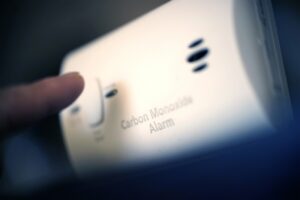Gas furnaces have many components, and it can be easy to get confused about terms like “flame sensor” and “pilot assembly” and be unclear about just how critical a part is to your furnace’s ability to function. For simplicity’s sake, let us state for the record that without a heat exchanger, you don’t have a furnace. While other components are also very important to the function of your heater, and all problems should be addressed promptly by qualified technicians, a cracked heat exchanger is an emergency causing not only heating failure but also serious safety hazards.
So we’d like to help you understand what a heat exchanger is, how it works, why it might crack, and what to do if it does so that you can navigate that situation with the seriousness it requires.
What a Heat Exchanger Is
As the name indicates, this is the part that exchanges or transfers heat from the burning natural gas to the air that flows through your ductwork and out of the vents in your home. Their role is essential in conducting that heat to where it is needed, and also critical to preventing toxic gasses from contaminating the air you and your family breathe.
How Heat Exchangers Work
Combustion gasses go from the furnace jets into the contained environment of the heat exchanger. Air is circulated around the now-hot outside of the heat exchanger by the blower. That air warms up and is conducted through your ductwork and into your living areas. The heat exchanger is the component that separates those gasses from the air. If it is cracked, dangerous fumes including potentially-deadly carbon monoxide are able to seep out into your home.
Why Heat Exchangers Crack
The primary reason for a cracked heat exchanger is simply ageing. It rarely occurs in a furnace that is less than fifteen years old. The reaction between the gas and the metal, and the constant expansion and contraction from heating and cooling, can take quite a toll over the decades.
How to Identify a Cracked Heat Exchanger
There are two sounds you are likely to hear if your heat exchanger has developed a crack. One is a clicking sound after the heating cycle ends, which is caused by the metal cooling and contracting. The other sound is your carbon monoxide detectors going off. This is obviously a situation you’d rather avoid, so the best way to keep track of your heat exchanger is to schedule annual maintenance. Your technician will inspect the heat exchanger and for any corrosion or cracking, so you will know for sure if your furnace is completely safe to operate or if you need furnace repair in West Monroe, LA.
What to Do if You Suspect a Crack
Because of the extreme hazard risk, you should consider this an emergency. If your carbon monoxide alarm is going off, evacuate immediately. The furnace should be shut off, and you should call for emergency heating service.
Contact Mike Smith Heating & Air Conditioning, LLC. We provide “Professional grade service.”

